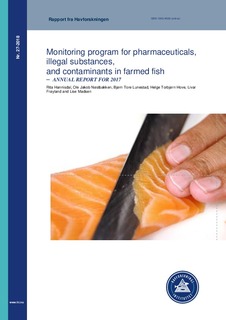| dc.contributor.author | Hannisdal, Rita | |
| dc.contributor.author | Nøstbakken, Ole Jakob | |
| dc.contributor.author | Lunestad, Bjørn Tore | |
| dc.contributor.author | Hove, Helge Torbjørn | |
| dc.contributor.author | Frøyland, Livar | |
| dc.contributor.author | Madsen, Lise | |
| dc.date.accessioned | 2018-10-25T12:39:08Z | |
| dc.date.available | 2018-10-25T12:39:08Z | |
| dc.date.created | 2018-10-12T13:17:54Z | |
| dc.date.issued | 2018 | |
| dc.identifier.uri | http://hdl.handle.net/11250/2569608 | |
| dc.description.abstract | This report summarises the monitoring data collected in 2017 on the status of illegal substances, pharmaceuticals and contaminants in Norwegian farmed fish. A total of 13 640 fish were collected, of these almost 40% were analysed for illegal compounds, approximately 35% were analysed for veterinary drugs, and about 25% were examined for contaminants. Official inspectors from the Norwegian Food Safety Authority performed the sampling.
Samples examined for illegal compounds could be collected at all stages of farming and are representative of farmed fish under production. The samples were analysed for substances with anabolic effects or unauthorized substances. No residues of illegal compounds were detected.
Samples tested for approved veterinary drugs were collected at processing plants, and are representative of Norwegian farmed fish ready for human consumption. Residues of three anti sea lice agents; Emamectin, cypermethrin or diflubenzuron, were found in 16 samples. The levels present were below the Maximum Residue Limit (MRL) for all samples. Other veterinary drugs, like antibiotics or drugs used against internal parasites, were not found.
Samples analysed for contaminants were collected at processing plants, and are representative of Norwegian farmed fish ready for the human consumption. The samples were analysed for dioxins, dioxin like PCBs (dl-PCBs), indicator PCB (PCB-6), pesticides, metals, PAH, PFC or/and BFR. No environmental contaminants were found above the EU maximum limits. The declining trend that previously has been observed for several of the contaminants seems to have stopped and today’s level are similar to the results from the last years. | nb_NO |
| dc.language.iso | eng | nb_NO |
| dc.publisher | Havforskningsinstituttet | nb_NO |
| dc.relation.ispartof | Rapport fra havforskningen | |
| dc.relation.ispartofseries | Rapport fra havforskningen;27-2018 | |
| dc.title | Monitoring program for pharmaceuticals, illegal substances, and contaminants in farmed fish - annual report for 2017 | nb_NO |
| dc.title.alternative | Monitoring program for pharmaceuticals, illegal substances, and contaminants in farmed fish - annual report for 2017 | nb_NO |
| dc.title.alternative | Overvåkingsprogram for legemidler, ulovlige stoffer og forurensende stoffer i oppdrettsfisk | nb_NO |
| dc.type | Research report | nb_NO |
| dc.description.version | publishedVersion | nb_NO |
| dc.source.pagenumber | 30 | nb_NO |
| dc.source.issue | 27-2018 | nb_NO |
| dc.identifier.cristin | 1620007 | |
| dc.relation.project | Havforskningsinstituttet: 15221 | nb_NO |
| cristin.unitcode | 7431,35,0,0 | |
| cristin.unitcode | 7431,33,0,0 | |
| cristin.unitcode | 7431,1,0,0 | |
| cristin.unitname | Sjømat i modellsystem | |
| cristin.unitname | Fremmed- og smittestoff | |
| cristin.unitname | Ledelse | |
| cristin.ispublished | true | |
| cristin.fulltext | original | |
